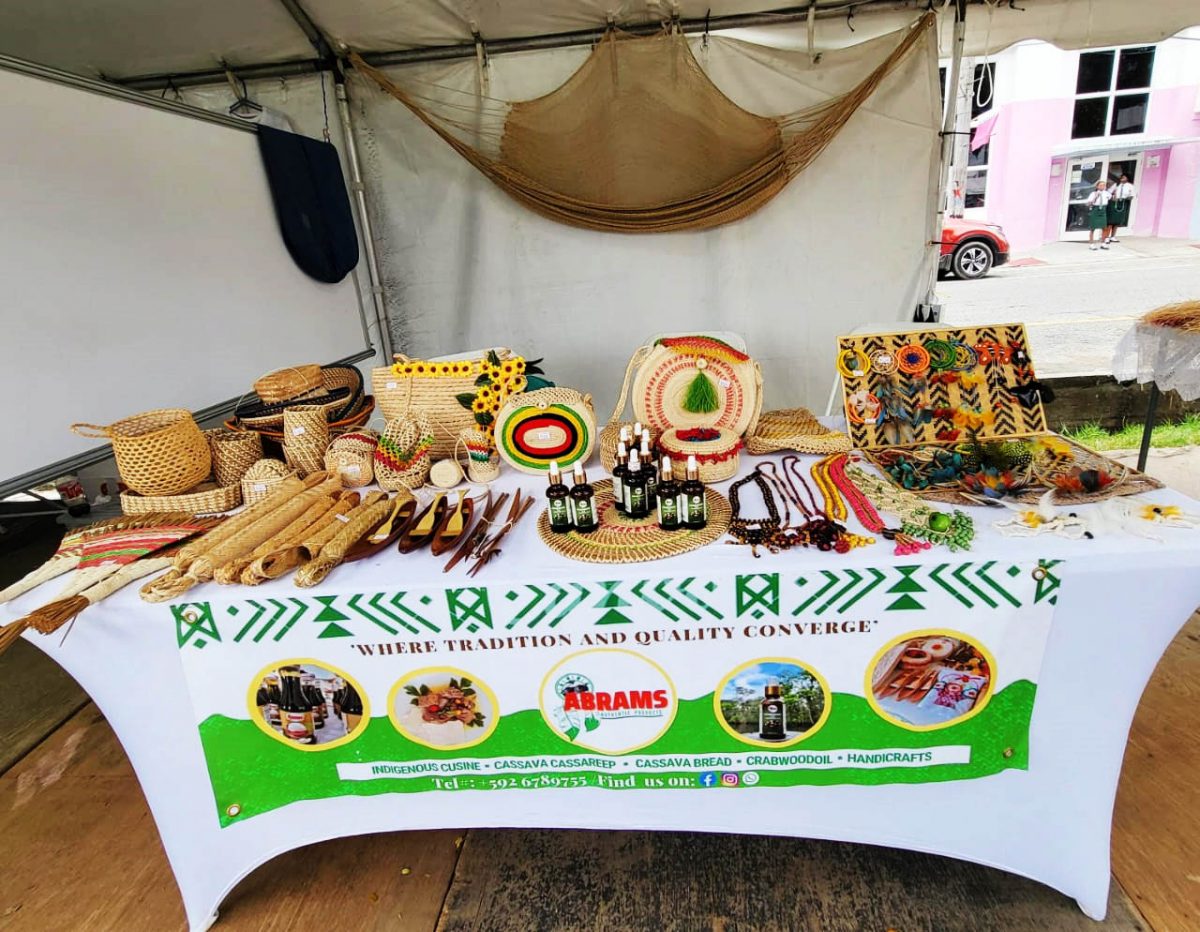A University of the West Indies lecturer with whom the Stabroek Business spoke with last week whilst viewing an indigenous culinary and craft display on Main Street Avenue made the point that up until now Guyana had failed, “and signally so,” to properly embrace what he described as “valuable” indigenous skills and creativity to bear within the country’s entrepreneurial mainstream. He elaborated, making the point that the creative work that had been displayed and were being diligently marketed for several days as part of the Heritage Month commemoration activities, had surely now reached a point in terms of their quality where they ought to be inducted into the country’s entrepreneurial mainstream, as is the case in other countries in the hemisphere. He went on to make the point that it was high time that Guyana take ‘a leaf from the books’ of those other South American nations that had long brought their clothing, their craft and their culinary offerings to the fore, making the point that such a gesture would go some way towards compensating for what he described as the “historic exclusion of our Amerindians from the socio cultural mainstream.”
He went on to cite that some countries in South America had made the point of ensuring that visitors have access to a profusion of indigenous creations and that in some instances those had become an important part of both the creative and the commercial frontline of those countries. They had “earned their places in high street stores and eating houses” he said. He then went on to describe contrasting approaches to “’celebrating’ Guyana’s Amerindian heritage” like the “off and on official attempts to raise the indigenous profile,” as exercises in “embarrassing condescension”, simultaneously making the point that the responsibility of “bringing our indigenous people into the mainstream” should be undertaken “utilizing monies taken from our oil earnings.” He believed that Guyana had arrived at a point in terms of its “oil earnings” where the excuse of “lacking the material means” was no longer tenable. In essence, he was making what came across as a near flawless case for taking measures beyond what he described as “those patronizing ones,” measures which he said would cause our Amerindian communities to feel “connected and counted in a manner that they do not appear to be at this time.”
He had “no objection,” he said to walking into the ‘high end shops’ in the city and seeing ‘Haute Couture’ indigenous craft and clothing being displayed for sale; nor, he said would he have the slightest objection to catching glimpses of the names of at least some of the range of Amerindian cuisine on the menus of the Pegasus and the Marriott. By the same token, he made no secret of his belief that these things had been lacking, over the years, for the reason that government had settled for a “tokenistic approach” to treating with the country’s Amerindians people. “Amerindians do not need patronage,” he declared. “They need to be afforded their fair share to which they are entitled.” If, of late, you would have wanted to secure pieces of Amerindian jewelry, craft or clothing, your best bet was to visit one of those hut-size stalls in downtown Georgetown, where you would have found “a sprinkling” of indigenous offerings on display for a limited time. This raises the question as to whether Amerindian cuisine, craft and fashion may not be ideal entrepreneurial areas to probe in terms of seeking to determine what these pursuits might yield in terms of creating life-changing entrepreneurial openings for Amerindians equipped with the requisite skills and perhaps, more importantly, for the overarching enrichment of our Guyanese culture.
Truth be told, our coastal political administrations have had more than sufficient time to contemplate these matters and they have come perilously close to ‘drawing a blank.’ When the conversation shifted to the fact that events like Heritage Month and other occasional relevant product promotion opportunities could help realize the ‘integration’ that we continually crow about, our visiting friend from UWI made a scathing remark to the effect that the authorities in Guyana had failed, miserably, over time, to acknowledge the material value in Amerindian craft and creativity, opting, instead, to treat what Amerindians, historically, have had to offer in an tokenistic way. This, he suggested, was the best that governments had been able to do, a means through which to make the point that “Amerindians count” as part of the Guyanese socio-cultural milieu. This he said was “simply not enough.”
The conversation was unfolding whilst we were strolling down the Main Street Avenue, two Thursdays ago, ‘taking in’ what was, in fact, a ‘healthy’ eye-catching product display event that probably lacked the level of attendance it deserved. The display of indigenous products, food, craft and fashion, was as bountiful as it was eye-catching. The range of indigenous eatables that turned out on the Main Street Avenue raised questions as to whether it might not be altogether appropriate to follow our South American ‘neighbours’ down the road of bringing tradition into the mainstream by putting some oil money into the creation of suitable coastal outlets for the clothing, craft and cuisine that continue to be created by indigenous hands. While these are probably likely to take time to take the fancy off the urban market we must begin from the position that we have to start somewhere. After all, it should be borne in mind that Guyana is gradually metamorphosing into what we might call a ‘high traffic area’ for the rest of the world and that the market is probably likely to grow way beyond the culinary offerings that have been available on Main Street recently.
Last Thursday evening, an Amerindian woman offering cooked alligator from her stall, was attracting an impressive little curious congregation, some of whom were taking gingerly bites into the meat. Others appeared to be vigorously contemplating whether they too should ‘take the plunge’ or whether they should try to locate a culinary offering of a more ‘conventional’ nature. At a time when business pursuits, mostly, attracts significant numbers of visitors some of whom may have, a few years ago, had no interest whatsoever in Guyana, there is an evident need for robust responses at the levels of both the public and private sectors. It is a matter of inexcusable shame that up to this time neither government nor the private sector has thought it fit, (individually or collectively) to erect an elaborate Indigenous Mall in the capital where the creative aspects of our Amerindian Heritage can be displayed and marketed. Here, one cannot help but think that such a move would serve to significantly market Guyana and, specifically, an aspect of the country’s heritage that has been largely patronized over the years.
Here, it has to be said that given the effort that, presumably, has to be made to put the Main Street event together, one feels compelled to wonder whether the event was sufficiently well-marketed, in the first place. ‘If we are going to open up more opportunities through which to afford creative and industrious Amerindian people a more generous entrepreneurial space, then the groundwork should be done in a manner that covers all the angles.’ Not sufficient, it seems, has been done, over time, to bring Heritage Month and what it has to offer into mainstream Guyana. The omission bespeaks a historic official deficiency in our mindfulness of our Amerindian heritage, a posture that leaves room for considerable criticism. If, historically, the state has always handled badly, blunt, open and mostly valid criticism of how we see and treat with indigenous people, it has, up to this time, not provided us with anything even remotely resembling a commensurate response. This, too, has to change.








